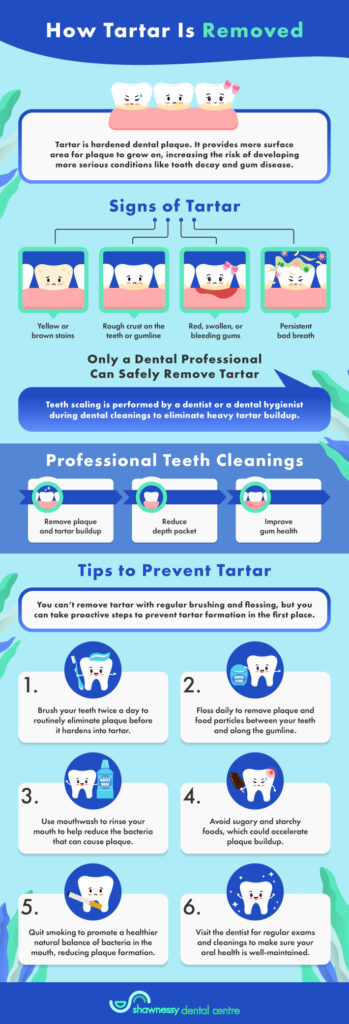Tartar can be an aesthetic concern since it often makes your teeth appear discoloured. While you may be tempted to remove tartar yourself, only a dentist or a dental hygienist can safely remove tartar from your teeth.
At home, you can help control tartar buildup by practicing good oral hygiene to routinely eliminate plaque.
What Is Tartar?
Tartar, or dental calculus, is a hardened form of dental plaque.
Plaque is a sticky and colourless film of bacteria that forms on your teeth, at the gumline, or underneath the gumline. Plaque accumulates on everyone’s teeth when food particles mix with saliva. However, if the plaque is not removed through regular brushing and flossing, it hardens into tartar.
What Does Tartar Buildup Look Like?
Tartar can vary in appearance depending on its severity and location. Unlike plaque, which is clear and colourless, tartar is typically yellow or brown. Above the gumline, tartar is more visible and can give the teeth a stained or discoloured appearance.
Below the gumline, tartar may be harder to detect.
What Happens if Tartar Is Not Removed?
Tartar contains dead bacteria and saliva that have mineralized. It provides more surface area for plaque to grow on, increasing the risk of developing more serious conditions like tooth decay and gum disease.
Tartar can irritate the gums and lead to gingivitis—the earliest stage of gum disease. If left untreated, gingivitis can progress to periodontitis, a severe form of gum disease that can cause tooth loss.
As the bacteria in tartar stick to your teeth, they can also cause enamel erosion and lead to cavities.
Additionally, tartar buildup can also cause:
- Gum recession
- Bad breath
- Staining
Can I Remove Tartar at Home?
Unlike plaque, which you can remove through regular brushing and flossing, plaque cannot be removed at home. Once plaque hardens into tartar, you need a dentist or a dental hygienist to safely remove tartar during a professional dental cleaning.
You should see your dentist twice a year to have your teeth professionally cleaned. They can remove plaque and tartar that may have formed between your visits to help maintain your oral health.
Why Do I Keep Getting Tartar?
Since tartar builds due to food particles and saliva mixing with plaque, everyone is prone to tartar. Some people may have naturally porous tooth enamel or produce more saliva than others, which can increase plaque and tartar formation.
Most commonly, tartar is a result of poor oral hygiene. However, even the most diligent brushers and flossers can develop tartar, especially underneath the gumline.
Additional factors that can contribute to developing tartar include:
- Genetics
- Sugary diets
- Tobacco use
How Do Dentists Diagnose & Treat Tartar?
A dental examination can detect tartar buildup. Gentle yet thorough dental cleanings help remove tartar and hard-to-reach plaque to prevent associated dental complications.
Attempting to remove tartar without a dentist can lead to tooth damage and increase the risk of tooth loss.
Dental cleanings typically start with scaling, where small tools gently remove plaque and tartar from the teeth and beneath the gumline. Scaling helps eliminate buildup that regular brushing and flossing can’t reach.
Scaling also reduces the depth of pockets around your teeth, which helps reduce bacteria and improves gum health.
Your dentist may also check for cavities, gum disease, and other potential oral health issues. Early detection is the best way to prevent more serious conditions down the line.

How to Prevent Plaque & Tartar Buildup
The best way to prevent tartar buildup is to routinely address plaque.
Brush Regularly
Brushing your teeth twice a day with fluoride toothpaste can help eliminate plaque before it hardens. Use a soft-bristled toothbrush or an electric toothbrush, and make sure you clean all surfaces of your teeth—including the front, back, and chewing surfaces.
Use a gentle, circular motion to avoid damaging your gums. You should also replace your toothbrush every 3–4 months or sooner if the bristles become frayed.
Floss Daily
Your toothbrush can’t reach some places, so flossing is just as important. Use about 45–50 cm of dental floss, winding most of it around each middle finger. Gently slide the floss between your teeth to remove plaque and food particles between the teeth and along the gumline.
Rinse with Mouthwash
Antiseptic mouthwash can reduce the bacteria in the mouth that cause plaque. Rinsing with mouthwash can help reach areas that your toothbrush and floss may miss, providing you with an extra layer of defence against tartar buildup.
Mouthwash containing fluoride can also help strengthen tooth enamel and prevent decay. To maximize its benefits, swish the mouthwash in your mouth for about 30 seconds.
Monitor Your Diet
Sugary and starchy foods provide abundant sources of nutrients for bacteria to thrive. When bacteria break down sugars, they produce an acidic environment that promotes plaque formation and contributes to tooth decay.
Opt for a balanced diet rich in fruits, vegetables, lean proteins, and whole grains. Drinking plenty of water can also help wash away food particles and neutralize acids in the mouth.
Avoid Smoking
Smoking and using tobacco products can reduce saliva production and alter the natural balance of bacteria in the mouth, facilitating plaque and tartar formation. They can also lead to several other dental issues like gum disease, tooth decay, tooth loss, and oral cancer.
Since they affect your blood vessels, they may even slow healing and affect the body’s ability to repair the gums. These products also make it harder for your immune system to fight infections.
Schedule Routine Exams & Cleanings
Regular dental visits help monitor and maintain oral health. Dental professionals have the tools and skills necessary to remove tartar and prevent other oral concerns. Your dentist can also provide personalized advice based on your oral health assessment.
Since some people may be more prone to plaque and tartar buildup than others, you should ask your dentist how often you should get your teeth cleaned. They can recommend a schedule based on your specific dental health situation.
Dental Cleanings & Exams in Calgary
Maintaining oral health involves a combination of daily practices, lifestyle choices, and routine dental visits. While you can’t remove tartar without a dentist, you can take preventive steps to mitigate buildup between visits.For thorough, personalized dental care, contact our team at Shawnessy Dental. Through our routine exams and cleanings, we can help eliminate stubborn plaque and tartar to help preserve your dental health.


